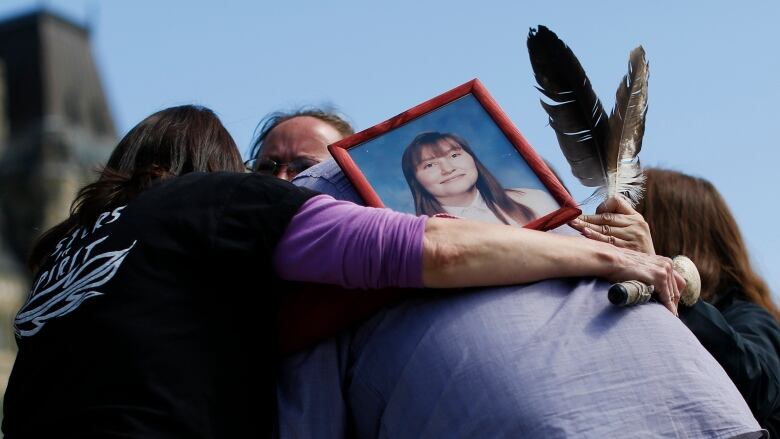Government Operations Centre monitored missing and murdered Indigenous women rallies
Charged with alerting government to public safety problems, the GOC also monitored environmental protests

An operations centre charged with alerting the federal government to potential threats to public safety monitored demonstrations calling for an inquiry into murdered and missing Indigenous women.
It is not known how long the Government Operations Centre (GOC) kept tabs on what Public Safety officials described as "protest activities."
A question placed on the House of Commons order paper by NDP MP Charlie Angus asked about surveillance carried out since Oct. 31, 2015. The government tabled its response when the House returned from its winter break on Jan. 30.
The monitoring described in the response likely began during former Conservative prime minister Stephen Harper's government and continued after Liberal Prime Minister Justin Trudeau's government came to power on Nov. 4, 2015.
Pam Palmater, who heads the Centre for Indigenous Governance at Ryerson University, said there was no reason for the government to monitor peaceful rallies and vigils.
"I'm pretty shocked … that they were following all of the rallies and events around murdered and missing Indigenous women, because all of them to date have really been about raising awareness, demanding a national inquiry," she said. "You didn't see anybody doing anything violent. There were no threats to do anything violent."
The MMIW inquiry — which has since been launched and held its first news conference Tuesday — is charged with examining the disappearance of hundreds of Indigenous women and girls. The federal government has pledged $40 million over two years for the inquiry.
Estimates of just how many women went missing vary. In 2010, the Native Women's Association of Canada identified 582 missing or murdered women and girls. A RCMP report in 2014 put the number at 1,181.
Idle No More, environmental protests also watched
Demonstrations calling for a MMIW inquiry were among several Indigenous and environmental protests on the GOC's radar, according to the document quietly tabled in Parliament.
Other movements that were monitored included Idle No More and protests against the Trans Mountain Expansion Project, the Northern Gateway pipeline, the Energy East and Eastern Mainline Projects, and the Lower Churchill Hydroelectric Generation Project.

But the GOC didn't monitor protests against the Site C Dam Project, the Line 9B Reversal and Line 9 Capacity Expansion Project, or Canadians travelling to demonstrations against the Dakota Access pipeline near the Standing Rock Indian Reservation in North Dakota.
In response to the question posed by Angus, the government says it has "maintained awareness" of the demonstrations but insists it doesn't conduct surveillance on the groups.
- MMIW commission off to a bumpy start as director let go
- MMIW inquiry gets low grades in 1st report card
"The GOC works closely with its partners to continuously improve its awareness of events that may affect national interest," Public Safety Canada wrote. "The GOC does not conduct surveillance operations nor does it conduct intelligence gathering."
The operations centre was aware of the protests "in order to maintain awareness of events that may impact federal government infrastructure," officials said.
"The GOC maintained awareness of these protests in accordance with its reporting criteria. The information identified generally consists of the date, location and purpose of the protests."
'Deeply unsettling'
The operations centre assesses an average of 3,500 incidents a year, according to officials, and did not produce any situation reports related to Indigenous protests.
"Most of these events do not meet the criteria to issue an alert to government and trigger a risk assessment, planning and co-ordinated response."

However, Angus said he found it "disturbing" that an operations centre designed to watch for public safety threats was monitoring MMIW demonstrations at all.
"The fact that they're keeping tabs on the murdered and missing women protests jumped out at me. It struck me as really disturbing and deeply unsettling," he said.
"These are very emotional marches of families who are grieving. Why would the government think this would be a threat to public safety?"
Bill C-51
It will be important to pay attention to the GOC's activities, Angus said, because of Bill C-51, the anti-terrorism law passed by the former Conservative government, which expanded the powers of police and intelligence agencies.
"Under Bill C-51, we have to share security information with the United States and we have an American president who thinks the rule of law is inconvenient," he said.
Palmater echoed those sentiments about Bill C-51, saying while MMIW demonstrations shouldn't have been on the radar, given the adoption of the legislation, she's not entirely surprised that they were.

"We warned the government and Canadians that any Indigenous activities would be included," she said. "We knew at the time that Idle No More was being monitored, and sure enough, I'm not surprised to see the rallies and events of murdered and missing indigenous girls are there."
While the government describes the GOC's activities as maintaining awareness, Palmater said keeping tabs on when and where events are taking place, and who is involved, counts as surveillance.
"It's no surprise that we're being surveilled," she said. "It's just for them to include rallies around murdered and missing Indigenous women is ridiculous."
Government's Answer to Question Tabled by Charlie Angus (PDF KB)
Government's Answer to Question Tabled by Charlie Angus (Text KB)CBC is not responsible for 3rd party content

